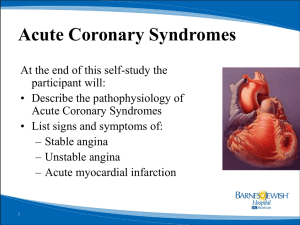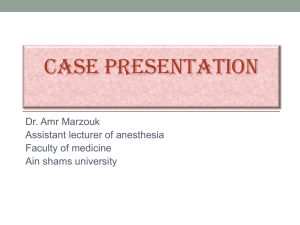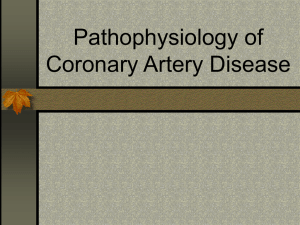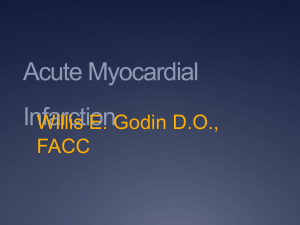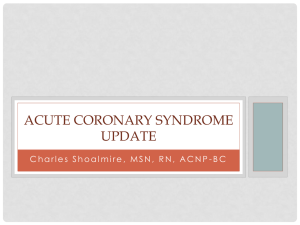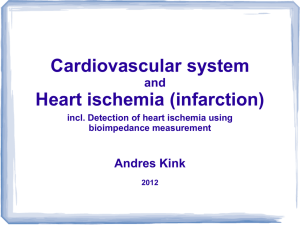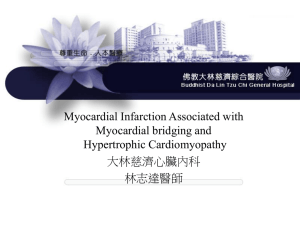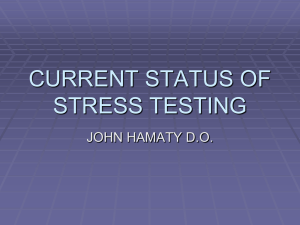Acute Myocardial Infarction
advertisement
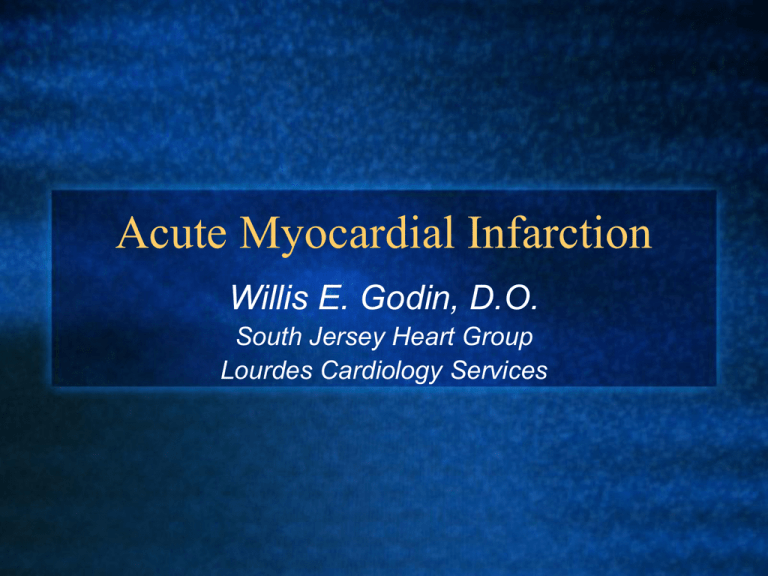
Acute Myocardial Infarction Willis E. Godin, D.O. South Jersey Heart Group Lourdes Cardiology Services Acute Coronary Syndrome (ACS) Refers to the array of clinical signs and symptoms produced by acute myocardial ischemia Unstable angina Non-ST-segment-elevation ST-segment-elevation MI MI Each condition shares common pathophysiologic origins related to the instability and rupture of artherosclerotic vulnerable plaques Unstable angina and NSTEMI Differentiated one from the other by primarily by their severity Whether the ischemia is prolonged enough to lead to structural myocardial damage and to the release of detectable markers of myocardial injury Troponin I (TnI) Troponin T (TnT) Creatine kinase (CK)-MB Coronary heart disease Major cause of morbidity and death in the United States Affecting approximately 16 million Americans Someone in the US experiences a coronary event every 25 seconds, and someone dies from a coronary event every minute. More than 1.4 million hospitalizations for ACS in the US each year Direct and indirect costs of CHD are estimated to be more than $165 billion in 2009 alone Pathophysiology Unstable angina and NSTEMI result from a disparity between myocardial oxygen delivery and demand, which usually presents as angina occurring with limited physical activity or at rest (a crescendo pattern). Demand-and-delivery mismatch Associated with UA/NSTEMI Can occur because of dynamic obstruction from: Intense arterial spasm Progressive, severe, flow-limiting atherosclerosis due to intimal hyperplasia or to lipid, calcium, and thrombus deposition, or to fibrointimal hyperplasia after PCI Coronary artery dissection Conditions that alter myocardial oxygen demand or supply, such as intense emotion, tachycardia, or uncontrolled systemic hypertension (secondary MI) Pathophysiology The most frequent mechanism of ischemia during limited physical activity or at rest is a primary reduction of the myocardial oxygen supply due to rupture or ulceration of a vulnerable atherosclerotic plaque Results in endothelial injury and associated thrombosis and dynamic vasoconstriction Pathophysiology Plaque fissure or rupture exposes the highly thrombogenic subendothelium to circulating platelets and white blood cells, which in turn activates the coagulation cascade The resultant platelet adhesion and aggregation at the site of plaque disruption leads to transient thrombosis or subtotal coronary artery occlusion with dynamic vasoconstriction Activated platelets release powerful promoters of vasoconstriction and platelet aggregation, including thromboxane A2, serotonin, adenosine diphosphate, and platelet-activating factor Plaque Rupture Can occur in mildly or severely stenosed coronary arteries Often occurs in arteries where the atherosclerotic lesions previously had caused only mild-to-moderate obstruction Duration of ischemia The duration of ischemia caused by the platelet-fibrin thrombi and severe dynamic vasoconstriction determines the overall clinical picture. If ischemia is neither severe nor prolonged (usually <20min) and oftern occurs at rest, patients are given a diagnosis of UA If ischemia lasts longer than 30 minutes and is associated with elevated cardiac markers, the diagnosis of MI is made Further classification as STEMI or NSTEMI is made on the basis of electrocardiographic findings. Pathophysiology Patients with UA/NSTEMI remain at high risk for a new infarction and its sequelae, including sudden cardiac death, until the endothelial injury is repaired UA, NSTEMI, and STEMI represent a pathophysiologic continuum This concept has led to the development of effective pharmacologic therapies that, used in conjunction with careful and rapid riskassessment strategies and catheter-based therapies, improve outcomes in UA/NSTEMI patients. Atherosclerosis Progressive in nature Chronic inflammatory and multifocal disease involving medium- and large-sized arteries May begin in the subendothelium as early as in the 1st decade of life Usually develops in lesion-prone vascular areas that exhibit underlying endothelial dysfunction as a response to chronic, multifactorial injury to the arterial wall Endothelial injury Flow shear stress Hypertension Immune-complex deposition and complement activation Smoking Diabetes mellitus Aging Substance abuse Infection Mechanical injury (coronary angioplasty, stent placement, heart transplantation) Endothelial Dysfunction A process regarded as a precursor to the development of vascular disease Characterized by disruption of vesselwall homeostasis, which is signified by decreased vasodilation, increased vasoconstriction, increased oxidative stress and inflammation, deregulation of thrombosis and fibrinolysis, abnormal smooth-muscle-cell proliferation, and a deficient repair mechanism. Diagnosis & Risk Stratification Early risk stratification is vital in the timely diagnosis and treatment of ACS Assessment of patients with suspected ACS should include: Clinical history Physical examination 12 lead ECG Biochemical marker measurement Noninvasive risk stratification Clinical History A thorough clinical history is of utmost importance in the initial evaluation and treatment of patients with suspected ACS Typical symptoms of ACS include chest pain or discomfort that may or may not radiate to the arm, back, neck, jaw, or epigastrium Women and elderly patients are more likely to present with atypical features, such as shortness of breath, weakness, diaphoresis, nausea, and lightheadness Physical Examination Findings of patients with suspected ACS are often normal Attention must be paid to the presence of complications of ACS: Acute LV failure Hypotension S3 gallop New or worsening mitral regurgitation Pulmonary edema Electrocardiography Plays an important role in initial assessment, emergency treatment, prognostication, and subsequent decision-making regarding the definitive treatment of patients with suspected ACS High specificity for diagnosing STEMI Remains test of 1st choice Electrocardiography Complete (>90%) occlusion of the coronary arteries alters the electrical potentials of the epicardial surface and usually manifests itself as ST-segment elevation in 2 or more adjacent leads ST-segment depression associated with UA/NSTEMI is transient and dynamic. Its appearance is usually flat or downsloping Biochemical markers When ischemia is prolonged enough to produce myocardial necrosis, the integrity of the myocytic membrane is lost Cardiac enzymes and other substances then leak into the peripheral blood, and their elevated levels in the bloodstream are indicative of acute myocardial infarction (AMI) Biochemical markers Cardiac troponins: gold standard of biomarkers for establishing a diagnosis of AMI Previously, elevated levels of CK and its cardiac-specific isoform CK-MB were used to make a diagnosis of AMI Any elevation in the circulating levels of these biomarkers may provide a clinical distinction between UA and NSTEMI Cardiac Troponins Excellent independent markers of shortterm and long-term prognoses Risk of death within the first 42 days is directly proportional to cardiac troponin levels, and the prognostic information is independent of other clinical and electrocardiographic risk factors Cardiac Troponins Detectable in the serum 4-12 hours after onset of myocardial necrosis Peak 12-48 hours from symptom onset Serial sampling, including the acquisition of a baseline sample and a follow-up sample 8-12 hours after symptom onset, is recommended Risk Stratification Clinical features, ECG, and cardiac troponin levels are fairly insensitive for immediately ruling out ACS It is important to reliably stratify patients who are at high or low risk of an MI and who are likely to have adverse events in the near future TIMI score PURSUIT score GRACE score TIMI risk score TIMI IIB trial Primary endpoint was the composite of all-cause death, new or recurrent MI, or severe recurrent ischemia that prompts urgent revascularization by day 14 Simple 7-point score that can be calculated easily at the bedside Treatment strategies Initial treatment: Invasive vs. Conservative Despite the debate, it is now widely accepted that the initial medical therapy for patients with suspected ACS should include relieving the ischemia and preventing further myocardial damage Treatment strategies How clinicians go about this is largely dictated by the initial risk assessment and continued patient monitoring in a controlled environment Hemodynamically unstable patients with refractory ischemic pain are monitored in a critical care environment and are taken to the cardiac catheterization laboratory as soon as possible Most patients’ conditions stabilize after a brief period of medical therapy at which time they can be further triaged according to ACS guidelines Nitrates Endothelium-independent vasodilatory effects on the coronary and peripheral vascular beds Dilate venous capacitance vessels and peripheral arterioles Decrease preload and afterload Lead to decrease in both myocardial wall stress and oxygen demand Relieve coronary spasm in atherosclerotic vessels and increase oxygen delivery to the subendocardial region that is supplied by the severely narrowed coronary artery Nitrates ISIS-4 and GISSI-3 studies No survival benefit or decrease in recurrent myocardial infarction Should be used in patients who have refractory ischemic discomfort Contraindicated: Patients who have taken sildenafil, tadalafil, or vardenafil in the previous 24 hours Systemic hypotension Marked tachycardia Severe aortic stenosis Right ventricular infarct B-Adrenergic Blockers Decrease sinus node rate and atrioventricular node conduction velocity, systolic blood pressure, and contractile responses at rest and during exercise Decrease myocardial oxygen demand and increase the length of diastole Good anti-ischemic agents B-Blockers Recommended that ACS patients without contraindications should receive their initial dose of an oral B-blocker within the first 24 hours of medical therapy Overview of literature (1988) showed a 13% relative reduction in the risk of progression from UA to an MI Pooled analysis of 5 trials (2003) showed a 50% reduction in mortality at 30 days and 6 months Calcium channel blockers Reduces myocardial contraction and relaxation of vascular smooth muscle, which increases coronary blood flow Decrease afterload and heart rate, while relaxing the left ventricle and increasing arterial compliance 2 major classes: Dihydropyridine Nifedipine, amlodipine Nondihydropyridine Verapamil, diltiazem Calcium channel blockers Not routinely given to AMI patients due to lack of convincing evidence that they actually reduce death CCBs can be used as 3rd-line antiischemic agents (after nitrates and Bblockers) in patients who have elevated blood pressure or angina at rest Short acting nifedipine should be avoided due to increased adverse events Antiplatelet therapy Acetylsalicylic acid (Aspirin) Thienopyridines Ticlopidine Clopidogrel Prasugrel Aspirin Causes irreversible acetylation of serine 529 of cyclooxygenase (COX-1) in platelets and the endothelium, thereby preventing thromboxane A2 (TXA2) production and resultant platelet aggregation Aspirin Reduces the risk of angina, death, or MI by approximately 30% in patients with CAD 1994 - the Antiplatelet Trialists’ Collaboration meta-analysis of 174 trials (70,000 pts) 2002 - meta-analysis of 287 studies (135,000 pts) Thienopyridines Block P2Y12 receptor signaling to prevent production of adenyl cyclase, thereby inhibiting platelet activation through adenosine diphosphate (ADP) Limit ADP-mediated conversion of GPIIb/IIIa to its active form Mechanism of action is independent of and complementary to that of aspirin Ticlopidine 1st-generation thienopyridine In combination with ASA, reduces rate of vascular death and MI by 46% in NSTEMI patients Used less frequently than the newer thienopyridines because of its potential for side effects: Rash, nausea, neutropenia, thrombocytopenia Clopidogrel 2nd-generation thienopyridine Most widely used and studied ADPreceptor-blocking agent CAPRIE study (1996) : 19,185 pts CURE trial (2001) : 12,562 pts CHARISMA trial (2006) PCI-CURE trial (2001) Clopidogrel 9% relative risk reduction in adverse cardiovascular events (vascular death, MI, or ischemic stroke) when compared to aspirin - (CAPRIE) 20% reduction in the primary composite endpoint (cardiovascular death, MI, or stroke) up to 12 months of f/u - (CURE) 31% reduction in cardiovascular death or MI in patients undergoing PCI - (PCICURE) Glycoprotein IIb/IIIa Inhibitors Platelets are activated through multiple pathways, however, the “final common pathway” of platelet activation and aggregation invloves a conformational change of the GPIIb/IIIa receptors from a resting state to an active state Glycoprotein IIb/IIIa Inhibitors Abciximab Tirofiban eptifibatide Glycoprotein IIb/IIIa Inhibitors EPIC trial (1994) - 35% reduction in primary composite endpoint (death, MI, recurrent ischemia) in pts given abciximab vs placebo CAPTURE trial (1997) - 30% relative reduction of death, MI, or recurrent ischemia in pts given abciximab PRISM study (1998) - 32% reduction in death, MI, or recurrent ischemia in pts given tirofiban PURSUIT trial (1998) - 10% reduction in the relative risk of death and MI in pts given eptifibatide Anticoagulants Unfractionated heparin Low-molecular-weight heparin Enoxaparin dalteparin Factor X inhibitors fondaparinux Heparin Anticoagulative effect by activating and accelerating the proteolytic activity of plasma cofactor antithrombin (AT) Close and frequent monitoring of the activated partial thromboplastin time (PTT) is necessary to ensure that a safe therapeutic range is maintained Heparin (UFH and LMWH) FRISC trial (1997) - 63% relative risk reduction in death or MI in pts given dalteparin vs placebo ESSENCE trial (1997) - the risk of death, MI, or recurrent angina was significantly lower in pts given enoxaparin vs UFH (16.6% vs 19.8%) TIMI 11B trial (1999) - 14.3% risk reduction of death, MI, or need of urgent revascularization in pts given enoxaparin vs UFH Early-Conservative and EarlyInvasive Strategies Coronary angiography aids in defining the extent and location of CAD and in directing the definitive care strategy PCI/stenting CABG Medical management Angiography is an invasive procedure and there is a small risk of serious complications (~1 in 1,000 cases) Early-Conservative and EarlyInvasive Strategies In the early-invasive strategy, all patients without contraindications undergo coronary angiography with the intent to perform revascularization within 4 to 24 hours of hospital admission. The early-conservative strategy consists of aggressive medical therapy for patients TIMI-IIIB trial Compared an early-invasive strategy to an early-conservative strategy in UA/NSTEMI pts (1994) Primary endpoint: composite of death, MI, or abnormalities on a exercise stress test at 6 weeks No significant difference in the occurrence of the composite endpoint between the groups. However, the average length of initial hospitalization, the incidence of rehospitalization within 6 weeks, and the number of days of rehospitalization all were significantly lower in the early-invasive group VANQUISH trial Compared an early-conservative strategy to an early-invasive strategy (1998) Combined endpoint of death and nonfatal MI occurred in 3.3% of pts in the early-conservative group and 7.7% of pts in the early-invasive group (No benefit of early-invasive strategy) FRISC-II trial Compared an early-conservative strategy to an early-invasive strategy (1999) Incidence of the composite endpoint of death or MI was 9.4% in the early-invasive group and 12.1% in the early-conservative group Furthermore, angina symptoms and hospital readmissions were reduced by 50% with the use of the early-invasive strategy Conclusions ACS is associated with high rates of adverse cardiovascular events, despite recent therapeutic advances Plaque composition and inflammation are more important in the pathogenesis of ACS than is the actual degree of stenosis Conclusions The cornerstone of contemporary treatment remains early risk stratification and aggressive medical therapy, supplemented by coronary angiography in appropriately selected patients Conclusions An early-invasive treatment strategy is of most benefit to high-risk patients An early-conservative strategy is recommended for low-risk patients Conclusions Adjunctive medical therapy with ASA, clopidogrel, GPIIb/IIIa inhibitors, and either LMWH or UFH, in the appropriate setting, further reduces the risk of ischemic events secondary to thrombosis Anticoagulation and short- and long-term inhibition of platelet aggregation should be achieved by appropriately evaluating the risk of bleeding complications in each patient Our goal: enhance both short- and long-term event-free survival
